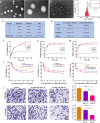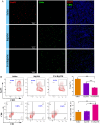Co-Delivery Nanomicelles for Potentiating TNBC Immunotherapy by Synergetically Reshaping CAFs-Mediated Tumor Stroma and Reprogramming Immunosuppressive Microenvironment
- PMID: 37545872
- PMCID: PMC10403052
- DOI: 10.2147/IJN.S418100
Co-Delivery Nanomicelles for Potentiating TNBC Immunotherapy by Synergetically Reshaping CAFs-Mediated Tumor Stroma and Reprogramming Immunosuppressive Microenvironment
Abstract
Purpose: Immune checkpoint inhibitors (ICI) have received the most attention for triple negative breast cancer (TNBC), while the response rate to ICI remains limited due to insufficient T cell infiltration. It is therefore essential that alternative strategies are developed to improve the therapeutic outcomes of ICI in non-responsive TNBC cases. The efficacy of pH-responsive nanomicelles (P/A/B@NM) co-loaded with paclitaxel (PTX), CXCR4 antagonist AMD3100, and PD-1/PD-L1 inhibitor BMS-1 activating the T cell-mediated antitumor immune response were evaluated using a 4T1 antiPD-1-resistance breast tumor model.
Methods: In vitro, pH-responsive antitumor effect of P/A/B@NM was investigated by assessing cell viability, migration and invasion. In vivo, the distribution of P/A/B@NM was visualized in 4T1 orthotopic TNBC model using an IVIS spectrum imaging instrument. The efficacy of the co-delivery nanocarriers was evaluated by monitoring mouse survival, tumor growth and metastasis, cancer-associated fibroblasts (CAFs)-mediated tumor stroma and immunosuppressive microenvironment components, and the recruitment and infiltration of CD8+ T cells.
Results: The prepared P/A/B@NM in acid microenvironment demonstrates remarkable cytotoxicity against MDA-MB-231 cells, with an IC50 of 105 μg/mL. Additionally, it exhibits substantial inhibition of tumor cell migration and invasion. The P/A/B@NM based on co-delivery nanocarriers efficiently accumulate at the tumor site and release the drugs in a pH-responsive controlled manner. The nanomedicine-PTX, AMD3100, and BMS-1 formulation significantly inhibits tumor growth and lung/liver metastasis by inducing antitumor immune responses via CXCL12/CXCR4 axis blockade, and immunogenic cell death to reprogramme both tumor stroma and immunosuppressive microenvironment. As a result, CD8+ T cell infiltration is triggered into the tumor site, boosting the efficacy of ICI therapy synergistically.
Conclusion: These results demonstrate that combination therapy using P/A/B@NM reshapes CAFs-mediated tumor stroma and immunosuppressive microenvironment, which can enhance the infiltration of CD8+ T cells, thereby reactivating anti-tumor immunity for non-responsive TNBC cases.
Keywords: CAFs; TNBC; co-delivery nanomicelles; immunosuppressive microenvironment; immunotherapy.
© 2023 Zhang et al.
Conflict of interest statement
The authors report no conflicts of interest.
Figures









Similar articles
-
Synchronous targeted delivery of TGF-β siRNA to stromal and tumor cells elicits robust antitumor immunity against triple-negative breast cancer by comprehensively remodeling the tumor microenvironment.Biomaterials. 2023 Oct;301:122253. doi: 10.1016/j.biomaterials.2023.122253. Epub 2023 Jul 25. Biomaterials. 2023. PMID: 37536040
-
Nanoparticle-integrated dissolving microneedles for the co-delivery of R848/aPD-1 to synergistically reverse the immunosuppressive microenvironment of triple-negative breast cancer.Acta Biomater. 2024 Mar 1;176:344-355. doi: 10.1016/j.actbio.2024.01.009. Epub 2024 Jan 18. Acta Biomater. 2024. PMID: 38244662
-
Nanoparticle-mediated blockade of CXCL12/CXCR4 signaling enhances glioblastoma immunotherapy: Monitoring early responses with MRI radiomics.Acta Biomater. 2024 Mar 15;177:414-430. doi: 10.1016/j.actbio.2024.02.007. Epub 2024 Feb 14. Acta Biomater. 2024. PMID: 38360292
-
Advancements in Stimulus-Responsive Co-Delivery Nanocarriers for Enhanced Cancer Immunotherapy.Int J Nanomedicine. 2024 Apr 8;19:3387-3404. doi: 10.2147/IJN.S454004. eCollection 2024. Int J Nanomedicine. 2024. PMID: 38617801 Free PMC article. Review.
-
Checkpoint inhibitors in triple-negative breast cancer (TNBC): Where to go from here.Cancer. 2018 May 15;124(10):2086-2103. doi: 10.1002/cncr.31272. Epub 2018 Feb 9. Cancer. 2018. PMID: 29424936 Review.
Cited by
-
Research progress of paclitaxel nanodrug delivery system in the treatment of triple-negative breast cancer.Mater Today Bio. 2024 Nov 23;29:101358. doi: 10.1016/j.mtbio.2024.101358. eCollection 2024 Dec. Mater Today Bio. 2024. PMID: 39677523 Free PMC article. Review.
-
Regulation of cancer-associated fibroblasts for enhanced cancer immunotherapy using advanced functional nanomedicines: an updated review.J Nanobiotechnology. 2025 Mar 4;23(1):166. doi: 10.1186/s12951-025-03217-0. J Nanobiotechnology. 2025. PMID: 40038745 Free PMC article. Review.
-
Cancer associated fibroblasts and metabolic reprogramming: unraveling the intricate crosstalk in tumor evolution.J Hematol Oncol. 2024 Sep 2;17(1):80. doi: 10.1186/s13045-024-01600-2. J Hematol Oncol. 2024. PMID: 39223656 Free PMC article. Review.
-
Nano-Drug Delivery Systems Targeting CAFs: A Promising Treatment for Pancreatic Cancer.Int J Nanomedicine. 2024 Mar 18;19:2823-2849. doi: 10.2147/IJN.S451151. eCollection 2024. Int J Nanomedicine. 2024. PMID: 38525013 Free PMC article. Review.
-
Assessment of CuFeSe2 ternary nanozymes for multimodal triple negative breast cancer theranostics.Nano Converg. 2025 Apr 2;12(1):18. doi: 10.1186/s40580-025-00483-4. Nano Converg. 2025. PMID: 40175784 Free PMC article.
References
MeSH terms
Substances
LinkOut - more resources
Full Text Sources
Research Materials
Miscellaneous

